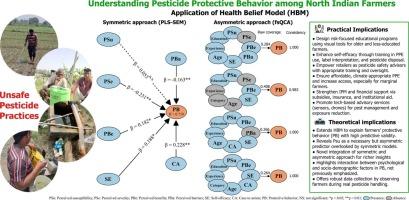了解印度北部农民对农药使用的保护行为:使用PLS-SEM和fsQCA的健康信念模型方法
IF 11.2
1区 社会学
Q1 ENVIRONMENTAL STUDIES
引用次数: 0
摘要
农业中不安全的农药使用对人类和环境健康构成严重风险。然而,保护措施的行为驱动因素仍然知之甚少,特别是在集约化农业导致农业生态系统退化的印度北部。本研究采用偏最小二乘结构方程模型(PLS-SEM)和模糊集定性比较分析(fsQCA)相结合的综合框架,通过健康信念模型(HBM)对农民的保护行为进行了研究。来自Hindon河流域的实地调查数据显示,广泛使用有害杀虫剂(世卫组织Ia、Ib和II类;>;7次使用/季),个人防护装备采用不当,以及不安全的处理和处置做法,导致急性健康症状,包括皮肤和眼睛刺激、头痛和头晕。虽然大多数农民认识到接触农药的健康风险,但对环境影响的认识仍然有限。PLS-SEM结果显示,行动提示(β = 0.228, p < 0.01)、自我效能感(β = 0.188, p < 0.05)和感知利益(β = 0.182, p < 0.05)显著促进了pbp,而感知障碍和感知严重程度对pbp有负面影响;感知易感性无直接影响。fsQCA证明了其间接作用,并确定了高感知易感性、感知利益、自我效能和教育的组合是加强PB的最有效途径。自我效能感是安全行为的核心条件,而缺乏行动线索则与不安全行为有关。这些发现突出表明,需要有针对性的、针对特定群体的干预措施,如培训、认识和管理措施,以便为发展中国家类似农业背景下的综合环境卫生政策提供信息。本文章由计算机程序翻译,如有差异,请以英文原文为准。

Understanding farmers' protective behavior towards pesticide use in Northern India: A health belief model approach using PLS-SEM and fsQCA
Unsafe pesticide use in agriculture poses severe risks to human and environmental health. Yet, the behavioral drivers of protective measures remain poorly understood, particularly in North India, where intensive agriculture has degraded the agroecosystem. This study investigated farmers' protective behavior (PB) through the Health Belief Model (HBM) using an integrated framework that combines Partial Least Squares Structural Equation Modeling (PLS-SEM) with Fuzzy-Set Qualitative Comparative Analysis (fsQCA). Field survey data from the Hindon River Basin revealed widespread use of hazardous insecticides (WHO Class Ia, Ib, and II; >7 applications/season), poor adoption of personal protective equipment (PPE), and unsafe handling and disposal practices, leading to acute health symptoms including skin and eye irritation, headaches, and dizziness. Although most farmers recognized the health risks from pesticide exposure, awareness of environmental impacts remained limited. PLS-SEM findings indicated that cues to action (β = 0.228, p < 0.01), self-efficacy (β = 0.188, p < 0.05), and perceived benefits (β = 0.182, p < 0.05) significantly promoted PB, whereas higher perceived barriers and perceived severity had negative effects; perceived susceptibility showed no direct effect. fsQCA demonstrated its indirect role and identified combinations of high perceived susceptibility, perceived benefits, self-efficacy, and education as the most effective pathways for strengthening PB. Self-efficacy emerged as a core condition for safe behavior, while the absence of cues to action was linked to unsafe practices. These findings highlight the need for targeted, group-specific interventions such as training, awareness, and regulatory measures to inform integrated environmental health policies in similar agricultural contexts across developing countries.
求助全文
通过发布文献求助,成功后即可免费获取论文全文。
去求助
来源期刊

Environmental Impact Assessment Review
ENVIRONMENTAL STUDIES-
CiteScore
12.60
自引率
10.10%
发文量
200
审稿时长
33 days
期刊介绍:
Environmental Impact Assessment Review is an interdisciplinary journal that serves a global audience of practitioners, policymakers, and academics involved in assessing the environmental impact of policies, projects, processes, and products. The journal focuses on innovative theory and practice in environmental impact assessment (EIA). Papers are expected to present innovative ideas, be topical, and coherent. The journal emphasizes concepts, methods, techniques, approaches, and systems related to EIA theory and practice.
 求助内容:
求助内容: 应助结果提醒方式:
应助结果提醒方式:


